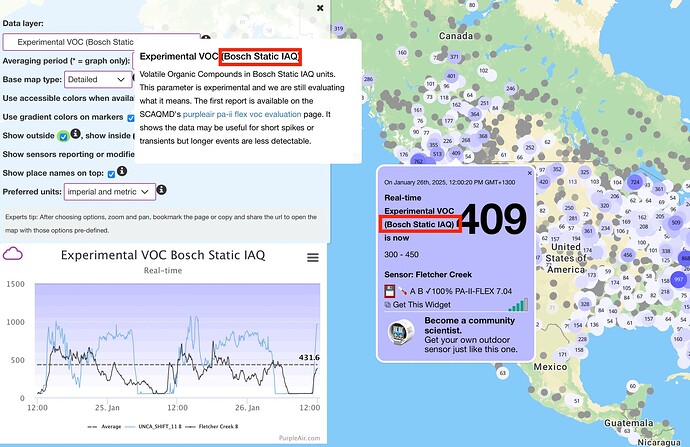Hi @Mrryan76,
You’re welcome. I hope the information has helped, and I also hope you and your family are safe.
It’s very hard to tell with PurpleAir because, as you mentioned, they are still labelling the VOC readings as ‘experimental’. However, based on what I was able to find in this forum post, it looks like they use the Bosch default output (another index).
Based on this datasheet, Bosch also outputs an index by default (similar to Sensirion).
AQMD also tested the accuracy of the VOC sensors in the PurpleAir monitors, and the results indicate the BME688 (and previous BME680) can pick up spikes and some short-term trends, but they shouldn’t be relied on to show the actual concentration and lose usefulness for identifying longer-term trends. With that said, AQMD’s testing seems to be carried out using the 0-500 index, whereas the PurpleAir map appears to have changed this index somehow.
While it still appears to be using an index (as opposed to trying to implement an ‘absolute’ conversion), it looks like PurpleAir has converted this index to be on a scale of 0-1500.
It’s worth noting that Bosch provides two indexes - IAQ and Static IAQ. IAQ is confirmed as being on a 0-500 scale, but I can’t find confirmation that Static-IAQ (which PurpleAir uses) is also on a 0-500 scale. I have heard it can go higher, but the AQMD testing linked above mentioned it also uses a 0-500 index. Therefore, it’s hard to tell if PurpleAir is using raw Static IAQ values or if they’re somehow converting the 0-500 scale to a 0-1500 scale for some reason. There doesn’t seem to be much information online explaining this. Frustratingly, I also can’t find any information as to what precisely ‘auto-trimming’ means in this case.
Based on this, here are my takeaways:
- PurpleAir is also using an index and not absolute values.
- They’re either showing the direct index output (Static IAQ) on the map or somehow converting it to a 0-1500 scale. Without knowing the scale of the Static IAQ, I can’t definitively say which of these is the case.
- Without knowing what auto-trimming means, it’s hard to tell exactly how the Static IAQ works. However, if I’m right in assuming that it means there are fewer algorithms dynamically adjusting the baseline, this could make it more useful than both the Bosch IAQ and Sensirion default output.
I would guess that, if the last conclusion about the Static IAQ is correct, the PurpleAir monitors are slightly better than most (non-manufacturer modified) Sensirion-based monitors. That said, as per AQMD’s report, even PurpleAir devices are not good for picking up longer-term trends, which seems to indicate some adjustments and algorithms are working behind the scenes.
Unfortunately, VOCs are just too hard to measure properly with low-cost equipment. It would also be great if the algorithms were more transparent so we could understand everything more confidently!


